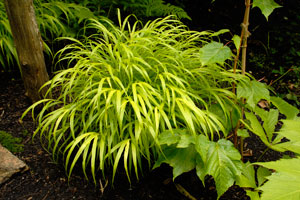6/27/2013
The Tricks to Growing Hakone Grass
Jeremy Windemuller

Hakonechloa is a popular ornamental grass for shade that can be produced to look its best during high traffic months at retail. Growers should seriously consider starting this grass the summer before it’s offered for sale, as those finished plants will be of the highest quality.
Potting and timing
Hakonechloa is a warm-season grass that benefits tremendously from planting in late summer for sales the following spring. These finished plants will be much fuller with a denser crown and will have a higher perceived value. If necessary, it may also be planted in spring for sales the same season.
For late summer planting, 20-ct plugs should be potted up into trade 1-gal. containers and grown for eight weeks so plants are established before winter dormancy. If starting from 72-ct plugs, allow 12 to 14 weeks for rooting before dormancy. Hakonechloa may be overwintered outdoors as long as it’s not held wet for extended periods.
When planted in spring, 72-ct plugs potted into trade 1-gal. containers finish in 12 to 16 weeks or 8 to 10 weeks in quarts. 20-ct plugs require 8 to 10 weeks to finish in trade 1-gal. containers in spring.
Cultural recommendations
Moisture: Monitoring moisture levels is a key factor in growing hakonechloa successfully. If drip irrigation or ebb and flow benches are available, use it for this crop. Overhead watering tends to push the foliage down onto the soil, preventing the water from getting to the roots and promoting foliage rot. Avoid overly dry conditions to prevent wilting or browning of the foliage, but also avoid overly wet conditions to prevent crown and root rot.
Lighting: Hakonechloa is a shade plant that will burn if grown in too much sun. Provide 30% to 55% shade during the summer months. Moderate light levels of 4,000 to 5,000 foot candles are best to achieve proper foliage
coloration.
Temperature: Hakonechloa is a slow-growing, warm-season ornamental grass that prefers average growing temperatures of 65 to 70F (18 to 21C). Growing this plant cooler will significantly increase the crop time.
Fertility and growing media: One critical factor in growing hakonechloa successfully is monitoring the EC level. An EC level of 1.75 to 2.25 using the pour-through method and a pH of 5.5 to 6.0 is recommended. Monitor these levels closely, as a high EC can cause root and crown rot. Hakonechloa is a light-to-moderate feeder. Fertilize with a constant liquid feed of 50 to 100 ppm nitrogen at every watering or a controlled-release fertilizer at a rate of 1.25 lb./cubic yard of growing media.
Hakonechloa prefers a growing media that’s balanced in its water retention properties—one that provides good drainage, but also retains an average amount of moisture. A peat/bark/perlite mix typically works well.
Pests and diseases: Hakonechloa is not typically bothered by pests or diseases if grown well. However, crown and root rot can be a problem if the crown is planted too deep, the salt levels (EC) are too high or the plants are grown too wet.
Finishing tips: Since hakonechloa is not grown for its flowers, no vernalization is necessary. When planted the summer before, finished vernalized plants require warm temperatures of 65 to 70F (18 to 21C) to initiate growth and are typically saleable in 8 to 10 weeks after emerging from dormancy.
GT
Jeremy Windemuller is a grower and trial manager for Walters Gardens, Inc. in Zeeland, Michigan.